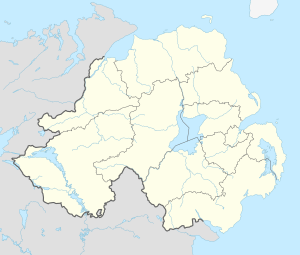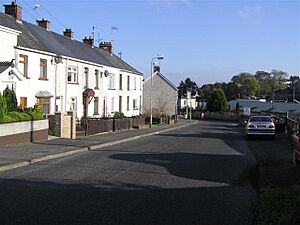1992 Coalisland riots facts for kids
Quick facts for kids 1992 Coalisland riots |
|||
|---|---|---|---|
| Part of the Troubles and Operation Banner | |||
| Date | 12 and 17 May 1992 | ||
| Location |
54°32′23.92″N 6°42′01.82″W / 54.5399778°N 6.7005056°W |
||
| Caused by | Provisional IRA attack on British army patrol near the village of Cappagh, County Tyrone | ||
| Resulted in |
|
||
| Parties to the civil conflict | |||
|
|||
| Casualties | |||
|
|||
| Another soldier lost his legs during the previous IRA bomb attack at Cappagh | |||
The 1992 Coalisland riots were a series of fights and disagreements. They happened on May 12 and 17, 1992. These events involved local Irish nationalist people and British Army soldiers. The soldiers were from the Third Battalion of the Parachute Regiment and the King's Own Scottish Borderers. The clashes took place in the town of Coalisland, County Tyrone, in Northern Ireland. The Parachute Regiment's mission in 1992 was called "Operation Gypsy".
Contents
What Started the Riots?
On May 12, 1992, a group called the Provisional Irish Republican Army (IRA) attacked a British Army patrol. This happened near a town called Cappagh, County Tyrone. The IRA used a hidden bomb. One soldier, Alistair Hodgson, was badly hurt and lost both his legs. Other soldiers also got minor injuries.
This attack made some soldiers from the Parachute Regiment very angry. They went to nearby Coalisland, a town where most people were Irish nationalists. The soldiers caused trouble there. Some people thought the IRA attack was meant to make the soldiers overreact. This would make the soldiers even less popular with local people.
Before these events, the Parachute Regiment had already caused problems. A local activist and former politician, Bernadette Devlin McAliskey, had complained. She said the soldiers were beating people, shooting, and damaging property. A politician from the area, Ken Maginnis, also asked for the regiment to be removed. He had received many complaints about their behavior.
The Clashes Begin
May 12: First Confrontation
Just two hours after the IRA attack in Cappagh, soldiers blocked off Coalisland. This town was about ten miles east of Cappagh. A local politician said the soldiers made up a fake bomb warning. However, the police said the operation started when people threw stones at a police and army patrol.
During this time, soldiers damaged two pubs and several cars. Some people said they were hit with sticks. After these events, a soldier in charge was suspended. The regiment was then removed from patrolling Coalisland.
May 17: Second Confrontation
On the evening of May 17, a fight started on Lineside Road. A group of young men were having drinks. A patrol of four soldiers from the King's Own Scottish Borderers regiment walked by. The young men dared the soldiers to a "boxing match." The soldiers put their weapons aside and fought with the youths.
Both sides reported injuries, but none were serious. The official report said a crowd of at least 30 people attacked the patrol. During the fight, a rifle and a machine gun were taken from the soldiers. The rifle was found nearby later. The young men also broke a radio left by the soldiers. Two soldiers were taken to the hospital.
The Parachute Regiment was called back to the scene. Around 8:30 p.m., a big riot began outside The Rossmore pub. About 20 to 25 paratroopers clashed with local people. The soldiers said one of their friends was pulled away by the crowd. Some witnesses said the paratroopers were very angry. They showed their guns and dared people to try to take them.
Suddenly, the soldiers fired shots. First, they shot into the air, then towards the people outside the pub. Three civilians were rushed to the hospital with gunshot wounds. The soldiers then went back to their barracks. Four other civilians had minor injuries. The paratroopers claimed someone in the crowd tried to fire the stolen machine gun at them, but it jammed. One of the injured civilians was the brother of a local IRA member, Kevin O'Donnell, who had died in February.
What Happened Next?
About 500 people gathered for a protest in Coalisland on May 19. Politicians in Dublin, Ireland, questioned why these soldiers were patrolling the town. The Minister for Foreign Affairs of Ireland, David Andrews, asked the British government to remove the regiment.
Because of this, the paratroopers were moved out of the town areas. The police said the stolen machine gun was found 11 days later near Cappagh. Another machine gun and an AK-47 rifle were also found. Some people wondered if the weapon was really stolen. They thought it might have been an excuse for the soldiers' actions. Bernadette McAliskey even suggested that finding the machine gun was a staged event by the security forces.
British officials blamed a political party called Sinn Féin for causing the riots. A British government official, Michael Mates, said the events were caused by "a gang of thugs motivated by the IRA."
In the end, the Parachute Regiment's time in Northern Ireland was cut short. Their patrols were stopped before they were officially supposed to leave. The commander of the Third Brigade, Brigadier Tom Longland, was replaced. This was the first time a high-ranking officer was disciplined this way during the Troubles.
The last patrol happened on June 27. On that day, two paratroopers drowned while crossing the River Blackwater. There were also more clashes with local people in the town of Cookstown on the same day.
The 3rd Battalion of the Parachute Regiment was replaced by the 1st Battalion of the Coldstream Guards.
Six soldiers faced legal action for their part in the May riots. They were found not guilty a year later. The judge said the soldiers were "not entirely innocent." Some people thought the ruling was unfair. A priest named Father Denis Faul believed the soldiers should have faced more serious charges. A TV show claimed that the Director of Public Prosecutions had recommended not to charge the soldiers. The soldier who lost his legs, Alistair Hodgson, said he would have acted the same way if another soldier had been hurt like him. Some writers suggested that sending this battalion to Coalisland made it harder for the British to keep peace.
More clashes between local people and soldiers happened in Coalisland on March 6, 1994. This was a few months before the IRA stopped fighting for a while.
See also
- Chronology of Provisional Irish Republican Army actions (1990–1999)
- 1997 Coalisland attack



